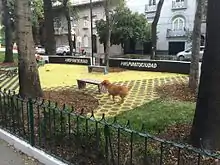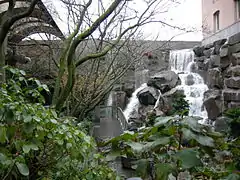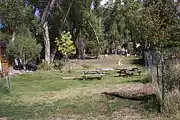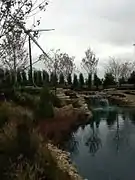Pocket park
A pocket park (also known as a parkette, mini-park, vest-pocket park or vesty park) is a small park accessible to the general public. Pocket parks are frequently created on a single vacant building lot or on small, irregular pieces of land and sometimes in parking spots. They also may be created as a component of the public space requirement of large building projects.


Pocket parks can be urban, suburban or rural, and can be on public or private land. Although they are too small for physical activities, pocket parks provide greenery, a place to sit outdoors, and sometimes a children's playground. They may be created around a monument, historic marker or art project.
In highly urbanized areas, particularly downtowns where land is very expensive, pocket parks are the only option for creating new public spaces without large-scale redevelopment. In inner-city areas, pocket parks are often part of urban regeneration plans and provide areas where wildlife such as birds can establish a foothold. Unlike larger parks, pocket parks are sometimes designed to be fenced and locked when not in use.
Small parks can increase the value of nearby homes. One study conducted in Greenville, South Carolina, found that "attractively maintained small and medium parks have a positive influence on neighboring property values."[1]
Around the world
Australia

Pocket parks, such as the Balfour Street Park, can be created from small unused areas of public land.[2]
Chile
In Santiago, Chile, the first pocket park (plaza de bolsillo) was created beside of Palacio La Moneda at Morandé Street.[3] It was an initiative of Architecture Departament of the Ministry of Public Infrastructure and Regional Government of Santiago.[4]
Mexico
In Mexico City, there is a city program to create up to 150 pocket parks of 400m2 or less on vacant lots or even on land that had been part of a large intersection, such as Jardín Edith Sánchez Ramírez and the Condesa pocket park.[5]
United Kingdom
In England, a 1984 project to involve the local community in the creation and running of small, local parks has fostered several pocket parks in Northamptonshire,[6][7] and was later developed by the Countryside Commission into the Millennium Green and Doorstep Green projects.
California
In Los Angeles, where there are restrictions on how close registered sex offenders can live to parks, local officials planned three pocket parks to drive "undesirables" from a given area.[8]
Ohio
In Columbus, Ohio, Polaris Founder's Park was opened in 2011 and holds a 35-foot wind sculpture.[9]
US Gallery
- Pocket parks
 Little Pearl Park
Little Pearl Park
Crestone, Colorado Founders Park
Founders Park
Columbus, Ohio.jpg.webp) Broad Street Park
Broad Street Park
Texarkana, Arkansas Greenacre Park, New York City
Greenacre Park, New York City
Canada
 Cloud Gardens
Cloud Gardens
Toronto
See also
References
- "Economic Benefits of Trails". American Trails. Retrieved 29 March 2012.
- MacGowen, Tempe (1 May 2012). "Balfour Street Pocket Park". ArchitectureAu. Retrieved 2015-08-10.
- "Morandé 83, la primera "Plaza de Bolsillo" de Santiago". Plataforma Urbana. Retrieved 2016-04-17.
- Mostrador, El. "La Plaza de Bolsillo Morandé 83, un oasis en la selva de cemento, un punto de fuga". El Mostrador. Retrieved 2016-04-17.
- "Parques Públicos de Bolsillo", Secretariat of Urban Development and Housing, Mexican Federal District, accessed 2014-10-07
- Pocket Park project Page 6&7
- Northamptonshire's Pocket Park Website Archived 2012-02-05 at the Wayback Machine
- Jennings, Angel (February 28, 2013). "L.A. sees parks as a weapon against sex offenders". Los Angeles. Los Angeles Times. Retrieved July 8, 2014.
- Evans, Walker. "Polaris Pocket Park Opens to the Public". Columbus Underground. Retrieved October 4, 2011.
External links
| Wikimedia Commons has media related to Pocket parks. |
